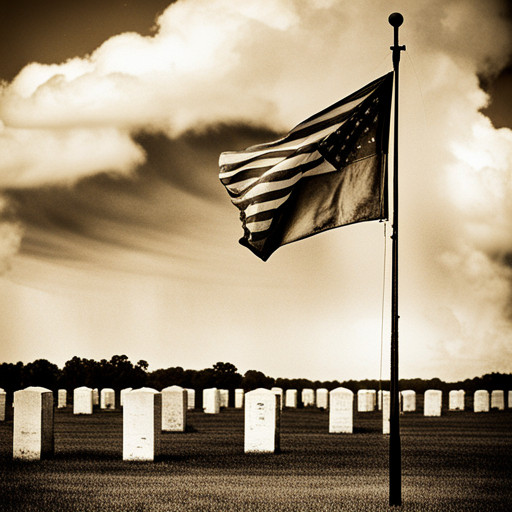From Loss to Legacy: Honoring the Undying Spirit of Camp Lejeune Victims
This article explores the poignant narrative of Camp Lejeune victims, navigating through their harrowing experiences to the subsequent commemoration efforts.

By analyzing historical events and personal stories, it uncovers a trajectory from tragedy to remembrance.
The piece further honors the unyielding spirit of these individuals and examines how tributes and memorials serve as an enduring legacy for future generations.
Key Takeaways
- Tragic history of Camp Lejeune and contamination of water supply with industrial solvents and chemicals
- Stories and advocacy of Camp Lejeune victims and their efforts towards justice and compensation
- Transition from pain to remembrance and the healing journey characterized by resilience narratives
- Indomitable spirit of Camp Lejeune victims and the celebrations of resilience as reminders of fortitude
The Tragic History of Camp Lejeune

The tragic history of Camp Lejeune is marked by unforeseen adversities, carving a narrative that spans decades and continues to impact the lives of many. Among the most prominent issues afflicting this military base was the contamination of its water supply - an event that would later necessitate a comprehensive Contaminated Water Analysis.
From 1953 through 1987, residents unknowingly consumed water tainted with industrial solvents and other chemicals, leading to health complications ranging from leukemia to birth defects. The primary pollutants were trichloroethylene (TCE), a metal degreaser, and perchloroethylene (PCE), a dry cleaning agent; both are classified as probable human carcinogens. According to estimates by the Agency for Toxic Substances and Disease Registry, as many as one million people may have been exposed.
In 1982 underground tanks leaked fuel around Hadnot Point, one of two principal water distribution points at Camp Lejeune. A subsequent analysis revealed alarming levels of contamination – up to 3800 times over permissible limits established by today's standards. Despite warnings from environmental engineers in the mid-80s about possible groundwater pollution risks, remedial action was not prioritized until several years later.
This incident brought forth questions regarding Military Accountability. It casts doubt on how such extensive contamination could occur without prompt detection or rectification measures taken by those accountable within the chain of command. Consequently, it has led to policy changes emphasizing more rigorous oversight mechanisms ensuring that potential environmental hazards at military installations be identified early and dealt with proactively before they escalate into public health crises.
Unveiling the Stories of Camp Lejeune Victims

Unveiling the narratives of those affected reveals a poignant, often heartbreaking chronicle of endurance and determination. The stories of Camp Lejeune victims are imbued with struggle against the health consequences they encountered due to prolonged exposure to contaminated water at the military base.
Efforts towards Victim Advocacy for these individuals have been long-standing, yet fraught with challenges. A closer examination reveals a concerted endeavor by survivors and their families to seek accountability, justice, and compensation for the adverse health impact experienced. This journey was underpinned by relentless advocacy efforts that sought to amplify their voices in legal corridors.
The spectrum of health consequences faced by victims is vast and distressing. Documented instances reveal an alarming prevalence of cancers such as leukemia, non-Hodgkin's lymphoma, liver, kidney and bladder cancer alongside other debilitating conditions like Parkinson's disease and aplastic anemia. These afflictions underscore the profound public health crisis that unfolded silently among this vulnerable populace over decades.
Analysis of Victim Advocacy campaigns often highlights an underlying sense of neglect felt amongst victims; a sentiment fueled by perceived indifference from responsible authorities towards their plight. Moreover, it underscores how stringent regulatory measures could have potentially mitigated this environmental disaster.
Thus, while honoring the enduring spirit of Camp Lejeune victims is paramount, it is equally critical to acknowledge their struggles in navigating complex legal landscapes amidst debilitating health crises. Their narratives serve as potent reminders for enhanced vigilance towards environmental hazards in military settings as well as underscore the urgent need for robust victim advocacy endeavors.
The Path From Pain to Remembrance

Transitioning from suffering to commemoration represents an essential process in acknowledging the hardships endured by these individuals and promoting awareness about the devastating health effects of environmental contaminations in military contexts. This shift, also known as the Healing Journey, takes root in resilience narratives that bear testament to victims' enduring spirit despite debilitating conditions.
The Healing Journey is characterized by a profound transformation, whereby individual pain is channeled into collective remembrance. It involves both sociological and psychological dimensions; on one hand, it fosters community solidarity by recognizing common experiences of loss and struggle; on the other hand, it promotes emotional healing through cathartic expressions of grief and determination.
Resilience Narratives play a crucial role in this journey. These are stories of fortitude that highlight the human capacity to cope with adversity. They serve dual purposes: firstly, they provide a source of inspiration for those undertaking similar battles against environmental contamination-induced diseases; secondly, they act as powerful advocacy tools that spotlight systemic issues leading to such disastrous situations.
As part of this path from pain to remembrance, commemorations have been organized at Camp Lejeune. These events honor victims while amplifying calls for recognition and justice. They embody a tangible expression of the Healing Journey—converting individual suffering into shared memory—and reinforce Resilience Narratives by illustrating how adversity can give rise to advocacy for change.
Celebrating the Indomitable Spirit of the Victims

Celebrations of resilience serve as potent reminders of the fortitude exhibited by individuals affected by environmental contaminations in military contexts. The scenario at Camp Lejeune, where victims were subjected to water contamination for decades, stands as a testament to this strength. The indomitable spirit displayed by these survivors is not merely an outcome of their survival but also a reflection of their resilience.
In looking closely at survivor resilience, it becomes apparent that such strength manifests itself in various forms. Some show resilience through their fight for justice and advocacy for policy change, while others demonstrate it through their will to survive against all odds. It is crucial to note that this resilience does not spring from isolation but rather flourishes within the collective support and shared experiences among the victims.
Victim empowerment emerges as another significant facet of these celebrations. Empowerment in this context transcends beyond mere survival; it encompasses active participation in legal battles against those who caused harm, involvement in awareness campaigns about environmental hazards, and engagement in supporting other survivors. It implies reclaiming control over one's life narrative and actively shaping the future course - both personal and societal.
Building a Legacy: Tributes and Memorials for Camp Lejeune Victims

In the aftermath of environmental disasters, the importance of commemorations and physical memorials dedicated to those affected becomes evident in fostering collective remembrance and historical consciousness. Memorial Architecture plays a significant role in shaping these commemorative spaces as it amalgamates design principles and symbolic elements to embody the experiences of victims, their resilience, and endurance.
A critical study of such memorial architecture reveals that it is not merely an aesthetic endeavor but serves a profound social purpose. Through thoughtful design, these structures encapsulate shared grief, channel collective healing, while providing a tangible tribute to victims' indomitable spirit. The architectural expressions may vary - ranging from monuments or sculptures to landscaped gardens or integrated urban spaces - but each project aims at immortalizing the memory of victims.
Moreover, victim advocacy groups play an instrumental part in facilitating these memorial projects. Their relentless efforts help articulate the necessity for such memorials – contributing significantly towards securing public support, funding provisions and requisite permissions for construction. Furthermore, they ensure that the narrative incorporated within these structures truthfully reflects the trials faced by victims.
In this context, when considering Camp Lejeune's legacy building initiatives through commemorative architectures; whether monumental or subtle gestures embedded within urban landscapes – each should be seen as emblematic representations of victim advocacy efforts over time. Each brick laid signifies an acknowledgment of past tragedies while inspiring future generations towards environmental stewardship.
Indeed, memorials serve as important catalysts in transforming loss into legacy - promoting societal reflection on historical events while affirming continuous solidarity with Camp Lejeune's undying spirits.
Frequently Asked Questions
What Immediate Steps Were Taken by the Government to Address the Health Issues Caused by the Contamination at Camp Lejeune?
In the contamination aftermath at Camp Lejeune, immediate governmental steps included extensive environmental clean-up, comprehensive health investigations, provision of healthcare benefits and victim support through compensation for those affected by toxic water exposure.
Are There Any Ongoing Investigations or Legal Actions Related to the Camp Lejeune Incident?
Investigations continue into the Camp Lejeune incident, with legal actions under consideration. Notably, these actions encompass issues of victim compensation and the broader legal implications arising from this significant environmental contamination case.
How Has the Contamination at Camp Lejeune Impacted the Local Environment and Wildlife?
The contamination at Camp Lejeune has yielded significant environmental consequences, notably impacting local wildlife. Alterations in habitat conditions necessitated adaptations among species, with some experiencing population declines due to the altered ecological balance.
How Have the Health Issues Caused by the Contamination at Camp Lejeune Been Addressed in the Medical and Scientific Community?
The contamination consequences at Camp Lejeune have been addressed through extensive research, epidemiological studies, and victim support in the medical and scientific community to understand and mitigate the health issues caused.
Were Any Policy Changes or Safety Measures Implemented in Other Military Bases as a Result of the Camp Lejeune Incident?
The Camp Lejeune incident spurred significant military reforms, particularly in contamination prevention. Enhanced safety protocols have been implemented across multiple military bases to prevent a similar occurrence of such environmental health hazards.
Conclusion
In conclusion, the legacy of Camp Lejeune victims extends beyond their untimely demise. Their indomitable spirit has inspired numerous tributes and memorials. Through these acts of remembrance, not only is their pain acknowledged, but their resilience celebrated.
This narrative serves as an important reminder of past mistakes and a beacon for future prevention strategies in environmental health and safety regulations within military installations worldwide.

This post has been generated by AI and was not reviewed by editors. This is Not legal advice. Please consult with an attorney.




